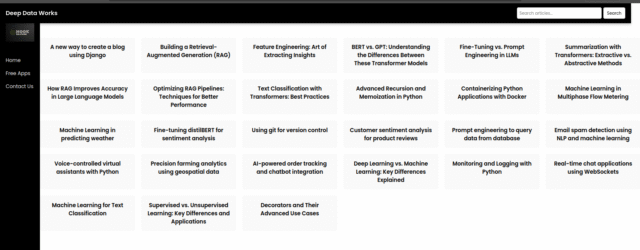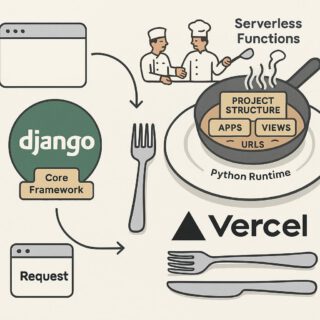Main Dish (Idea)
The core concept is a Django web application, designed to be served through Vercel’s serverless functions. This allows us to have a dynamic, Python-based backend that scales automatically with user traffic, without the need to manage servers directly. The application itself seems to be a blog with multiple features, including a chatbot, sentiment analysis, and PDF merging.
Ingredients (Concepts & Components)
- The Foundation (Django 4): The robust Python web framework, providing the structure, models, views, and templates to build the application.
- The Processor (Python Runtime on Vercel): Vercel’s environment for running Python code as serverless functions. This is where our Django application will “cook”.
- The Conduit (WSGI): The Web Server Gateway Interface bridges Django and the serverless environment, enabling the application to handle HTTP requests.
- The Router (URLs): Django’s URL configuration, routing incoming requests to the correct views/functions within the application.
- The Seasoning (Serverless Functions): Vercel’s serverless functions will be our individual courses (like the chatbot or sentiment analyzer), providing scalability and dynamic behavior.
- The Garnishes (Static Files & Media): CSS, JavaScript, images, and any uploaded files are handled separately, possibly using Vercel’s built-in static file serving or other storage solutions.
- The Toolkit (Dependencies): Python packages specified in
requirements.txtlike Django, ckeditor, pymongo, etc. - The Helper (Frontend): HTML templates (and possibly JavaScript and CSS) to render the web pages.
- The Utilities (Models): database models for blog posts, chat messages, etc.
Cooking Process (How It Works)
-
Preparation (Project Setup):
- Initialize a Django project and create apps like
blog,accounts,chatbot, etc. - Define models (e.g.,
Post,ChatMessage) to store data in a database (like SQLite, which is default). - Install necessary Python packages (like Django, ckeditor, pymongo, etc.) and list them in a
requirements.txtfile.
- Initialize a Django project and create apps like
-
The Base (Django Application):
- Create Django views (functions) to handle different functionalities like displaying blog posts, handling user input, etc.
- Design and create templates (HTML files) to present the data to users.
- Connect the Django views with the URLs to expose the application’s endpoints.
- Configure settings in
settings.py(e.g.,INSTALLED_APPS,ALLOWED_HOSTS,MEDIA_URL,STATIC_URL).
-
The Assembly Line (WSGI Configuration):
- Create a
wsgi.pyfile within the Django project, which loads the Django application instance. - Specify this WSGI application in
settings.pyby settingWSGI_APPLICATION.
- Create a
-
The Flavor Enhancers (Serverless Functions Integration):
- Vercel detects the
wsgi.pyfile and the Python runtime and automatically creates serverless functions. - Any request to the deployed Vercel URL is routed through this serverless function.
- The serverless function starts the Django application.
- Vercel detects the
-
The Plating (Request Handling):
- The Vercel infrastructure receives an HTTP request.
- The request goes through the Django application, handled by the serverless function.
- The request is matched with a URL and passed to the appropriate view.
- The view function processes the request, potentially interacting with the database (reading blog posts, etc.).
- The view generates an HTTP response (usually HTML).
- The response is sent back through Vercel’s infrastructure.
-
The Side Dishes (Static & Media):
- Static files (CSS, JavaScript, images) might be stored in a dedicated directory and served by Vercel.
- Media files (uploads) could be stored and served through cloud storage services (e.g., Vercel Blob, Amazon S3).
-
The Garnishing (Deployment):
- Deploy the project using Vercel’s one-click deployment or command-line interface.
- Vercel builds and deploys serverless functions, serving the Django application.
Serving Suggestion (Outcome)
The final dish is a fully functional Django web application, served through Vercel’s serverless infrastructure. This provides a scalable, easy-to-manage web presence that can handle traffic spikes automatically. Users can interact with the website, read blog posts, access features like the chatbot, sentiment analysis, and PDF merging. All of this without the burden of server management. The result is a dynamic, responsive, and readily deployable web solution.
https://deepdataworks.vercel.app/



